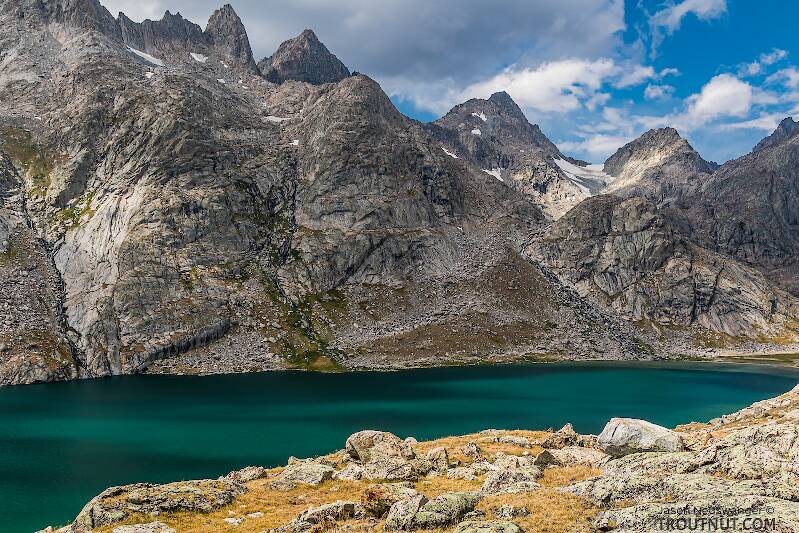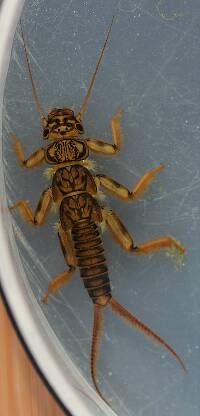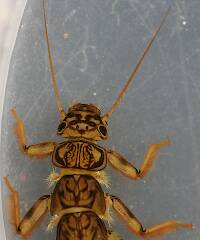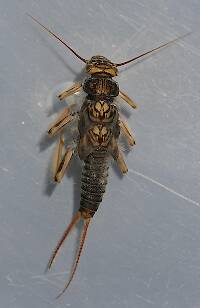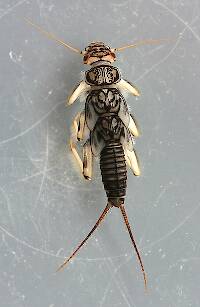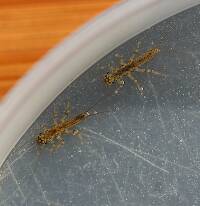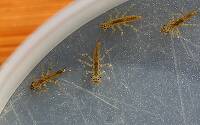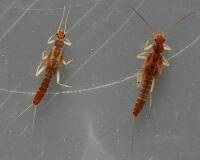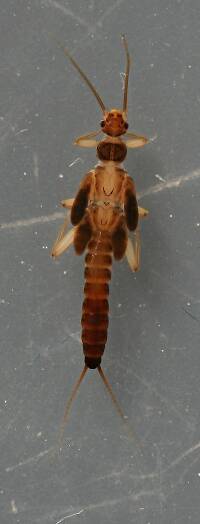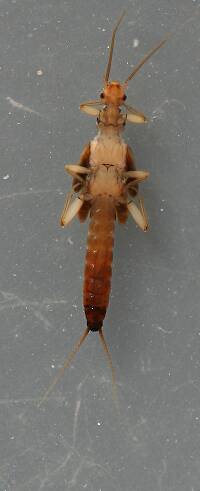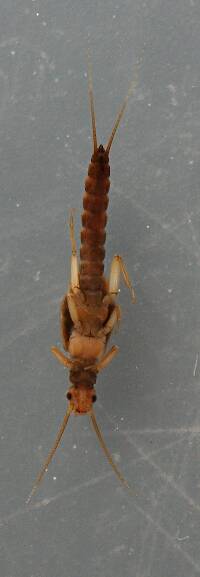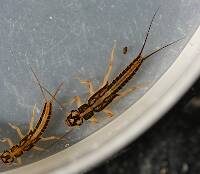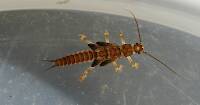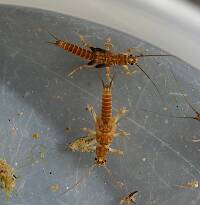
Salmonflies
Pteronarcys californica
The giant Salmonflies of the Western mountains are legendary for their proclivity to elicit consistent dry-fly action and ferocious strikes.
Featured on the forum

This species was fairly abundant in a February sample of the upper Yakima.

Troutnut is a project started in 2003 by salmonid ecologist Jason "Troutnut" Neuswanger to help anglers and
fly tyers unabashedly embrace the entomological side of the sport. Learn more about Troutnut or
support the project for an enhanced experience here.
DOS on May 28, 2009May 28th, 2009, 7:15 pm EDT
Collected in Cattaraugus CO. NY on May 17th from an intermittent spring seep flowing through a undisturbed, 400 acre stand of Allegheny hardwood. The stonefly nymphs were quite prolific, almost under every rock with a diameter larger than a CD. No adults to be found despite their apparent maturity.
The seep is also rich with caddis larva, several species of salamanders, crayfish and spotted newts higher up along the bank.
Appears to be family Perlidae .... is it just A. capitata with an interesting color variation??



Habitat...
where the seep upwells from the ground (looking downstream)



Salamander spices include...
Duskey Salamander ~ Desmognathus fuscus
Two Lined Salamander ~ Eurycea bislineata
Spotted Salamander ~ Ambystoma maculatum
(pictured) Four-toed Salamander ~ Hemidactylium scutatum


Crayfish

And my friend that foraged along with me in the seep just feet away...



The seep is also rich with caddis larva, several species of salamanders, crayfish and spotted newts higher up along the bank.
Appears to be family Perlidae .... is it just A. capitata with an interesting color variation??



Habitat...
where the seep upwells from the ground (looking downstream)



Salamander spices include...
Duskey Salamander ~ Desmognathus fuscus
Two Lined Salamander ~ Eurycea bislineata
Spotted Salamander ~ Ambystoma maculatum
(pictured) Four-toed Salamander ~ Hemidactylium scutatum


Crayfish

And my friend that foraged along with me in the seep just feet away...



Andrew Nisbet
GONZO on May 29, 2009May 29th, 2009, 7:10 am EDT
Great pictures, Drew. Your latest stonefly specimens are interesting, as is the location in which they were collected. They are not A. capitata. I doubt that they are perlids. Did you keep specimens? If so, can you confirm that they lack branched thoracic gills in their "armpits?" If the branched gills are absent (as they appear to be), they are probably perlodids of the subfamily Perlodinae, the "springflies."
Myersl on Apr 8, 2010April 8th, 2010, 3:56 am EDT
This looks to be the Perlodid stonefly, Malirekus iroquois.
myersl
Oldredbarn on Apr 8, 2010April 8th, 2010, 5:08 am EDT
Andrew,
I think your raccoon buddy is pissed you are nosing around in his honey-hole! Just the few samples you pulled from that little seep is the reason he's so fat, dumb, and happy.
It's incredible how much protein a little area like this will produce. That is why wet-lands are so important. Us guys on this site probably spend the majority of our time hipdeep in the middle of a good sized stream somewhere and overlook these little places. It all starts here!
In the headwaters.
I have been lucky to have stood in the middle of massive hatches or spinner falls that boggle the mind. The numbers are incredible. We sometimes get distracted from these other places. I spent a great deal of time as a youngster turning over rocks and logs myself around my grandparents farm in northern Michigan. Some of the kids of this generation unfortunately don't know what they are missing absorbed in their Gameboy world. That shit is dull!
Thanks for sharing your "stuff" with us.
Spence
I think your raccoon buddy is pissed you are nosing around in his honey-hole! Just the few samples you pulled from that little seep is the reason he's so fat, dumb, and happy.
It's incredible how much protein a little area like this will produce. That is why wet-lands are so important. Us guys on this site probably spend the majority of our time hipdeep in the middle of a good sized stream somewhere and overlook these little places. It all starts here!
In the headwaters.
I have been lucky to have stood in the middle of massive hatches or spinner falls that boggle the mind. The numbers are incredible. We sometimes get distracted from these other places. I spent a great deal of time as a youngster turning over rocks and logs myself around my grandparents farm in northern Michigan. Some of the kids of this generation unfortunately don't know what they are missing absorbed in their Gameboy world. That shit is dull!
Thanks for sharing your "stuff" with us.
Spence
"Even when my best efforts fail it's a satisfying challenge, and that, after all, is the essence of fly fishing." -Chauncy Lively
"Envy not the man who lives beside the river, but the man the river flows through." Joseph T Heywood
"Envy not the man who lives beside the river, but the man the river flows through." Joseph T Heywood
Jmd123 on Apr 8, 2010April 8th, 2010, 8:23 am EDT
I almost did a doctorate in aquatic entomology on the benthic macroinvertebrate communities of springs and their relationships to groundwater chemistry. These are absolutely fascinating little ecosystems with unexpected productivity and diversity, and in fact their own unique communities in many cases. And after a few of them run together they get big enough for brook trout and the like...I know a few places like this in northern lower MI and there are some very interesting insects in them too. Also, small rainwater-fed rivulets on the Oregon coast surprised me with their diversity as well - three to four families each of mayflies, stoneflies, caddisflies, true flies, aquatic beetles, true bugs, etc......
Jonathon
Jonathon
No matter how big the one you just caught is, there's always a bigger one out there somewhere...
Quick Reply
Related Discussions
Topic
Replies
Last Reply
2
Sep 11, 2010
by Adirman
by Adirman
1
Jan 29, 2016
by Martinlf
by Martinlf
1
Mar 9, 2012
by Wiflyfisher
by Wiflyfisher
0
Feb 21, 2018
by Millcreek
by Millcreek

